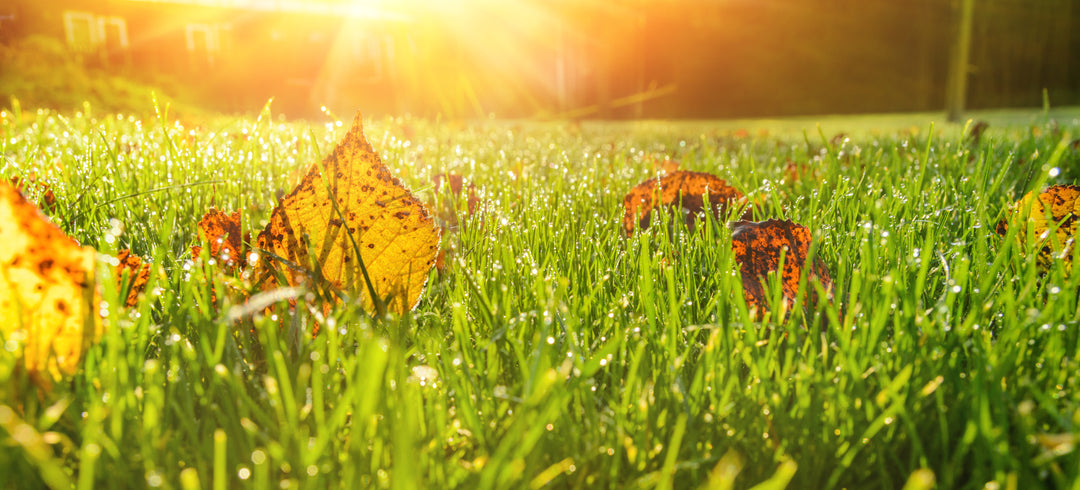Tips for lawn care in autumn
The temperatures are falling, the sun loses strength - in early autumn the right time is to repair the damage from summer, hopefully non -existent, and prepare the lawn for the upcoming winter.
After the long, hot summer, above and underground growth are now increasing noticeably again. Due to the still warm floor temperatures, coupled with mostly damp weather, the ideal time is now to carry out regeneration measures:
Anyone who has problems with soil compaction or heavy soil will now find the right conditions for aerification with the Lawnpecker. Soil air is an often underestimated topic! In addition to the advantages of root development and soil life, it is essential to derive excess water in autumn.
The wet weather not only offers good chances for the grasses, but also ensures ideal conditions for lawn diseases. Above all, it is important to keep the felt formation in the eye: felt stores a lot of moisture and thus offers a perfect basis for its pathogen. Depending on the variety composition and the general state of maintenance, a scarifying is now quite appropriate. Since possible felt formation causes problems all year round, it makes more sense in my eyes to generally observe felt formation and to keep it low by regular ventilation or groomers. From now on, regular dweling is very useful to ensure that the soil and the leaves are dried out quickly and the leaves - the Levelrake Optimal, regular, light top dressing also supports drying.
After aerification/scarifying or repairing damaged areas, you should definitely be sowing. Anyone who works with a high proportion of Lolium, pre -germinated or treated seeds manages to establish the new grasses within a short time. By using a rain period, you can not only save resources, but also avoids additional opportunities to offer additional chances, unwanted grasses, especially Poa Annua.
After that, of course, the lawn needs a refreshment: we do not want to push growth too much now, so you should rely on a fertilizer that contains only slowly acting nitrogen and is more of a calibration. Floor formula N: K 1: 2! While the nitrogen contained still ensures moderate growth and improves the absorption of potassium, potassium ensures, among other things, an increase in carbohydrate content in the plant and thus makes it more frost -resistant.
The full autumn follows early autumn, which is heralded with the potato harvest. The days are becoming noticeably shorter - similar to the midsummer, the photosynthesis performance is now dramatic! In order to counteract this, you should lift the cutting height slightly, depending on the current lawn length and variety. The following applies in particular to colleagues from the deep -cut fraction: each millimeter is worth gold if the ball roller behavior is irrelevant. If you are generally at 4-5cm cutting height, you can still keep this height. At the latest now, the autumn fertilization should be made to prepare the lawn for the winter period. A measurement of the pH value is now quite appropriate, since high pH values, especially in connection with a long, damp grass scorch, favor the infestation of lawn diseases. Due to the limited regeneration assets of the grasses at this point, you should keep the mechanical loads within limits: no scarifying! Mowing only after growth and playing, especially with soccer shoes, in the moist state are now rather inappropriate, but aerification with thin full sponsors can make sense to ensure a good air exchange, especially in the main root horizon, and to optimize the water outflow from the root zone. Now the porcupine is a very helpful tool in order to get a lot of air into the ground with as little damage to the grass scorch.
The late autumn begins with the general leaf fall. The most important measure now is to keep the lawn as deciduous as possible - the moisture cannot escape under the leaves and a microclimate forms here, which forms optimal conditions for fungal diseases. The floor temperatures have now dropped significantly and there is usually no or very little sprout growth, the mowing intervals can therefore be significantly extended. While I mow about three times a week in the main growth phase, I am now about a cut every three to four weeks. In order not to weaken the grasses unnecessarily at a cut at a cut, the knives should be as sharp as possible, since the growth is very weak, in my eyes you should lay the cut on one day when temperatures are as high as possible , so that the plants can seal the cuts as quickly as possible. With very fine -grained soils or problems with deeper compression you can now do well with the Lawnclaw Tiefenlockern - you make use of the principle of the frostgar: the water freezing in the ground creates space for soil life, oxygen, water and roots.
Author: Lars Koppe
After the long, hot summer, above and underground growth are now increasing noticeably again. Due to the still warm floor temperatures, coupled with mostly damp weather, the ideal time is now to carry out regeneration measures:
Anyone who has problems with soil compaction or heavy soil will now find the right conditions for aerification with the Lawnpecker. Soil air is an often underestimated topic! In addition to the advantages of root development and soil life, it is essential to derive excess water in autumn.
The wet weather not only offers good chances for the grasses, but also ensures ideal conditions for lawn diseases. Above all, it is important to keep the felt formation in the eye: felt stores a lot of moisture and thus offers a perfect basis for its pathogen. Depending on the variety composition and the general state of maintenance, a scarifying is now quite appropriate. Since possible felt formation causes problems all year round, it makes more sense in my eyes to generally observe felt formation and to keep it low by regular ventilation or groomers. From now on, regular dweling is very useful to ensure that the soil and the leaves are dried out quickly and the leaves - the Levelrake Optimal, regular, light top dressing also supports drying.
After aerification/scarifying or repairing damaged areas, you should definitely be sowing. Anyone who works with a high proportion of Lolium, pre -germinated or treated seeds manages to establish the new grasses within a short time. By using a rain period, you can not only save resources, but also avoids additional opportunities to offer additional chances, unwanted grasses, especially Poa Annua.
After that, of course, the lawn needs a refreshment: we do not want to push growth too much now, so you should rely on a fertilizer that contains only slowly acting nitrogen and is more of a calibration. Floor formula N: K 1: 2! While the nitrogen contained still ensures moderate growth and improves the absorption of potassium, potassium ensures, among other things, an increase in carbohydrate content in the plant and thus makes it more frost -resistant.
The full autumn follows early autumn, which is heralded with the potato harvest. The days are becoming noticeably shorter - similar to the midsummer, the photosynthesis performance is now dramatic! In order to counteract this, you should lift the cutting height slightly, depending on the current lawn length and variety. The following applies in particular to colleagues from the deep -cut fraction: each millimeter is worth gold if the ball roller behavior is irrelevant. If you are generally at 4-5cm cutting height, you can still keep this height. At the latest now, the autumn fertilization should be made to prepare the lawn for the winter period. A measurement of the pH value is now quite appropriate, since high pH values, especially in connection with a long, damp grass scorch, favor the infestation of lawn diseases. Due to the limited regeneration assets of the grasses at this point, you should keep the mechanical loads within limits: no scarifying! Mowing only after growth and playing, especially with soccer shoes, in the moist state are now rather inappropriate, but aerification with thin full sponsors can make sense to ensure a good air exchange, especially in the main root horizon, and to optimize the water outflow from the root zone. Now the porcupine is a very helpful tool in order to get a lot of air into the ground with as little damage to the grass scorch.
The late autumn begins with the general leaf fall. The most important measure now is to keep the lawn as deciduous as possible - the moisture cannot escape under the leaves and a microclimate forms here, which forms optimal conditions for fungal diseases. The floor temperatures have now dropped significantly and there is usually no or very little sprout growth, the mowing intervals can therefore be significantly extended. While I mow about three times a week in the main growth phase, I am now about a cut every three to four weeks. In order not to weaken the grasses unnecessarily at a cut at a cut, the knives should be as sharp as possible, since the growth is very weak, in my eyes you should lay the cut on one day when temperatures are as high as possible , so that the plants can seal the cuts as quickly as possible. With very fine -grained soils or problems with deeper compression you can now do well with the Lawnclaw Tiefenlockern - you make use of the principle of the frostgar: the water freezing in the ground creates space for soil life, oxygen, water and roots.
Author: Lars Koppe




